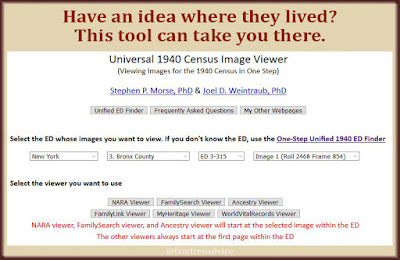When a search doesn't find your relative in the census, there is a tool that can help.
It's been 7 years since they released the 1940 United States Federal Census. And I still can't find a handful of my relatives. I've tried searching for them a bunch of ways. No luck!
 |
| Locate the group of census pages you need. |
If only I could go page-by-page through what I think was their neighborhood. Luckily, there's a tool to help us do that.
Computer professional Stephen P. Morse decided to make genealogy searches easier. His collection of tools focuses on the census (U.S., Canada, and U.K.), ship manifests, DNA, and more.
His Unified Census ED (Enumeration District) Finder helps you find the census pages for a particular address. Then you can start paging through the collection.
Let's walk through an example. My great aunt Edie married in 1936, but I've never found her in the 1940 census. Her marriage certificate says she and her husband-to-be lived 2½ blocks apart in the Bronx, New York. When I was a little girl, they lived next door to my grandmother. That building is between both of their 1936 addresses. I'll start my search there.
 |
| 4 steps to narrow down your search for the right census page. |
In the Stephen Morse tool I can enter a street address and it's smart enough to offer me the short list of cross streets. I can click a link to open Google Maps to that address to see which streets are near this address. Since this is a city address, I can enter several cross streets. I have the option of entering the 1930 enumeration district for this address if I have it (which I do). But we're already narrowed down to a single enumeration district as a result.
 |
| Click a button to find an address on the map and see its cross streets. |
 |
| Where to locate the enumeration district on a U.S. Federal census sheet. |
To find the enumeration district for an address, look at the top right corner of any Federal census sheet. You should see the supervisor's district and the enumeration district numbers.
Click the result link, then choose where you want to view the census pages. I'll go with Ancestry.com. In this case, my neighborhood of interest is part of a 26-page collection. I can focus on the names—particularly on the first names—and try to find my great aunt, her husband, and her daughter.
I found a military record that makes me think my great uncle was away from home in 1940. I'll concentrate on my great aunt and her daughter's first names. And I'll keep in mind that my great aunt went by at least 4 variations of her first name.
I've gone through these 26 pages a few times without finding my great aunt Edie. My grandparents, my great grandparents, and some cousins are in these 26 pages. But not the great aunt I'm looking for!
If my great uncle was away, were my great aunt and her baby staying with or near her mother-in-law? I can use the Stephen Morse website to search for that address, too. I'll follow the same steps as before:
- Choose the right census year
- Enter an address
- Click to view the map and find cross streets
- Start searching the pages
My great aunt's mother-in-law lived about a block away, but she was part of a different set of census pages. The Stephen Morse tool narrows down my search to 2 enumeration districts. One has 43 pages; the other has 32.
Side-note: I have so many relatives who lived in the Bronx, I'm seeing lots of familiar names on these pages. It helps to keep your family tree open to see if you need the page where you've found another relative.
I'm sorry to say I struck out and did not find my great aunt. But I found lots of people I know, like my Uncle Silvio as a little boy. I even found the guy my mom was once engaged to!
This is a good method that's worth trying. I'm going to pick another missing relative and try again.
No comments:
Post a Comment